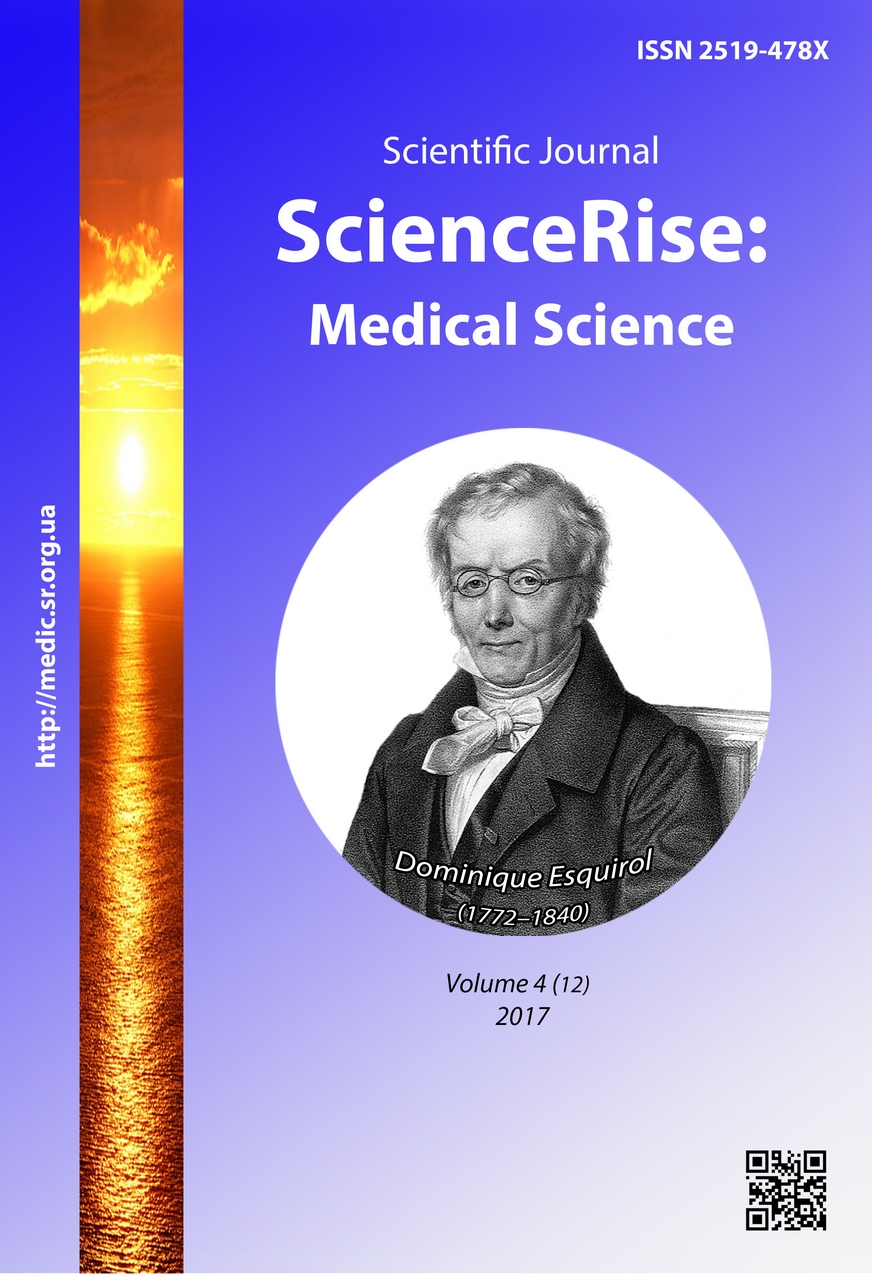A comparative analysis of the accumulation of lead acetate in blood plasma, urine and homogenates of hard dental tissues in rats
DOI:
https://doi.org/10.15587/2519-4798.2017.100481Keywords:
lead, atomic absorption spectrometer, plasma, urine, the homogenate hard dental tissueAbstract
Aim. A comparative analysis of lead acetate concentration in blood plasma, urine and homogenates of hard dental tissues in rats for determination of the informative value of indicators to estimate condition of lead acetate accumulation and metabolism depending on its accumulation degree.
Methods. The studies were carried out using 36 white mongrel male rats weighing 200–250 g. The animals were divided into two groups: the first (12 rats) – the control group, receiving ordinary water, the second group (24 rats) – the animals received lead acetate in a dose of 10 mg / kg of the the animal weight of in the form of a one-percent intragastric solution with drinking water daily during one, two and three months.
Results. In result of research devoted to determination of lead acetate in blood plasma, urine and homogenates of hard dental tissues in rats, its increase depending on the poisoning period duration was found, and the highest indices were marked after 3 months period.
Conclusion. A comparative analysis of the accumulation of lead acetate in blood plasma, urine and homogenates of hard dental tissues in rats using atomic absorption spectrometry was carried out. In result of the study we can conclude about the degree of lead acetate accumulation in homogenates of hard dental tissues and about the presence of subchronic lead intoxication (blood plasma, urine)
References
- Tchounwou, P. B., Yedjou, C. G., Patlolla, A. K., Sutton, D. J. (2012). Heavy Metal Toxicity and the Environment. Experientia Supplementum, 133–164. doi: 10.1007/978-3-7643-8340-4_6
- Trahtenberg, I. M., Dmitruha, N. M., Lugovskiy, S. P., Chekman, I. S. (2015). Svinets – nebezpechniy polyutant. Problema stara I nova. Suchasni problemi toksikologiyi, horchovoi ta himichnoi bezpeki., 3, 14–24.
- Kianoush, S., Balati-Mood, M., Mousavi, S. R. et. al. (2013). Clinical toxicological, biochemical and hematologic parameters in lead exposed workers of a car battery industry. Iran J. Med. Sci., 38 (1), 30–37.
- Verteletskaya, M. I., Semenova, K. A., Avramenko, L. P., Bolotnova, T. V. (2015). Struktura, klinicheskie osobennosti somaticheskoy patologii u rabochih svintsovogo proizvodstva. Akademicheskiy zhurnal Zapadnoy Sibiri, 1 (56), 10–11.
- Krotenko, I. S., Movchan, L. N., Alshevskaya, V. E., Zvereva, N. L. (2011). Vliyanie na zdorove naseleniya vyibrosov vrednyih veschestv avtotransporta. EkologIya Harkivschini: stan, problemi, perspektivi, 126.
- Erem, T. V. (2015). Harakteristika vmistu deyakih vazhkih metaliv u produktah harchuvannya, scho stanovlyat ratsion meshkantsiv Zakarpatskoyi oblasti. Enviroment&Health, 4, 23–25.
- Mason, L. H., Harp, J. P., Han, D. Y. (2014). Pb Neurotoxicity: Neuropsychological Effects of Lead Toxicity. BioMed Research International, 2014, 1–8. doi: 10.1155/2014/840547
- Sushanlo, R. Sh. (2016). Vliyanie svintsovoy intoksikatsii i gipoksii na serdechno-sosudistuyu sistemu (literaturnyiy obzor). Sibirskiy med. zh., 31 (3), 33–38.
- Mishra, K. P. (2009). Lead exposure and its impact on immune system: A review. Toxicology in Vitro, 23 (6), 969–972. doi: 10.1016/j.tiv.2009.06.014
- Vepryuk, Yu. M. (2013). Vozrastnyie osobennosti ionoreguliruyuschey funktsii pochek pri vozdeystvii solyami alyuminiya i svintsa v usloviyah gipofunktsii shishkovidnoy zhelezyi. The journal of scientific articles «Health & education millennium», 15 (1-4), 243–246.
- Dovgal, G. V. (2014). MorfologIchnI zmIni v rozvitku pechInki schurIv pri vplivI atsetatu svintsyu ta za umov korektsii v prenatalnomu periodi. Ukrayinskiy morfologIchniy almanah, 12 (1), 42–44.
- Lugovskoy, S. P., Legkostup, L. A. (2002). Mehanizmyi biologicheskogo deystviya svintsa na pischevaritelnuyu sistemu. Suchasni problemi toksikologii, 2, 45–50.
- Romanyuk, A. M., Saulyak, S. V., Moskalenko, Yu. V., Romanyuk, O. K., Shkroba, A. O. (2013). Morfologichni zmini u statevih organah (sim’yaniki, peredmihurova zaloza) v umovah vplivu na organizm soley vazhkih metaliv. Tavricheskiy mediko-biologicheskiy vestnik, 16 (1 (61)), 210–211.
- Ilicheva, S. A., Zaridze, D. G. (2015). Izuchenie kantserogennosti svintsa v kogortnom issledovanii muzhchin-rabotnikov tipografii Moskvyi.Gigiena i sanitariya, 5, 75–77.
- Kutsevlyak, V. F., Lahtin, Yu. V. (2011). Intensivnist kariesu zubiv sered naselennya, scho prozhivae v umovah pidvischenogo vplivu soley vazhkih metaliv. Novini stomatologiyi, 3, 58–60.
- Lahtin, Yu. V., Grigoreva, L. I., Polosuhin, V. A., Zorina, O. A. et. al. (2012). Vliyanie soley tyazhelyih metallov na vozniknovenie osnovnyih stomatologicheskih zabolevaniy. Kyiv: Ekologiya i zdorove naseleniya, 149–180.
Downloads
Published
How to Cite
Issue
Section
License
Copyright (c) 2017 Valentina Kutsevlyak, Natalia Bobrovska, Konstantin Belikov, Tatyana Sheina

This work is licensed under a Creative Commons Attribution 4.0 International License.
Our journal abides by the Creative Commons CC BY copyright rights and permissions for open access journals.
Authors, who are published in this journal, agree to the following conditions:
1. The authors reserve the right to authorship of the work and pass the first publication right of this work to the journal under the terms of a Creative Commons CC BY, which allows others to freely distribute the published research with the obligatory reference to the authors of the original work and the first publication of the work in this journal.
2. The authors have the right to conclude separate supplement agreements that relate to non-exclusive work distribution in the form in which it has been published by the journal (for example, to upload the work to the online storage of the journal or publish it as part of a monograph), provided that the reference to the first publication of the work in this journal is included.









